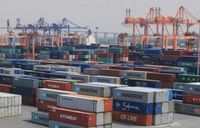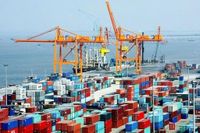Vietnam's trade landscape has shown remarkable resilience in the first four months of 2025, despite a slight dip in April's export-import turnover. According to the General Department of Customs, the total import-export turnover for April reached 74.31 billion USD, marking a decrease of 1.4% compared to March but reflecting a robust increase of 21.3% year-on-year.
In detail, exports for April amounted to 37.44 billion USD, a decline of 2.8% from the previous month, while imports remained steady at 36.87 billion USD. The trade balance for the month recorded a surplus of 0.57 billion USD, down significantly from 1.64 billion USD in March 2025.
Despite the monthly decline, the cumulative figures for the first four months of 2025 tell a different story. The total turnover surged to 276.89 billion USD, reflecting a 15.7% increase, equivalent to an additional 37.51 billion USD compared to the same period last year. Exports reached 140.34 billion USD, up 13%, while imports climbed to 136.55 billion USD, marking an 18.6% rise.
The trade surplus for the first four months stood at 3.8 billion USD, although this was a decrease of 58.2% compared to the same period in 2024, when the surplus was 9.05 billion USD. The state budget revenue from import-export activities in April was recorded at 39.732 trillion VND, a slight decrease of 0.6% month-on-month. However, the cumulative revenue for the first four months reached 142.122 trillion VND, accounting for 34.58% of the assigned estimate, which is a 12.1% increase from the same timeframe in 2024.
In the agricultural sector, the export turnover of agricultural, forestry, and fishery products reached 21.15 billion USD in the first four months, with an import turnover of 15.97 billion USD, resulting in a trade surplus of approximately 5.18 billion USD, down 4.1% year-on-year. Notably, exports of agricultural products alone reached 11.6 billion USD, up 11.7%, while forestry products saw exports of 5.56 billion USD, an increase of 11.2% compared to last year.
Seafood exports also performed well, with a turnover of 850 million USD in April, contributing to nearly 3.1 billion USD in the first four months, which is a 17% increase compared to 2024. Shrimp remained a standout product, generating 1.27 billion USD in exports during this period, reflecting a 30% increase year-on-year. In April, shrimp exports reached 330.8 million USD, up 15% from the previous month.
However, not all segments of the seafood market are thriving. Catfish exports, while still significant at 632.7 million USD, saw only a 9% increase, with April figures showing no growth compared to the previous year. This stagnation is largely attributed to US tariff pressures and competition from alternative sources like tilapia from Ecuador.
On a positive note, other seafood products, such as tilapia and red snapper, experienced a remarkable increase of 138%, reaching 19 million USD, driven by strong demand from China and emerging markets. Mollusks generated 216.4 million USD in exports, up 18%, while crab exports soared by 82%, reaching 83.1 million USD. Squid exports also increased by 50%, amounting to 112.1 million USD.
China and Hong Kong led as the primary markets for Vietnamese seafood, accumulating 709.8 million USD in the first four months, up 56%. April alone saw exports to these regions reach 182.3 million USD, primarily due to high demand for shrimp, crab, and mollusks catering to the premium segment. Japan followed as the second-largest market, with exports totaling 536.6 million USD, marking a 22% increase.
Despite the positive trends in other markets, the US market showed a more modest performance, with exports reaching 498.4 million USD, only a 7% increase, and a significant 15% decline in April. This downturn reflects the ongoing impact of current US tariffs, which have disrupted export activities.
Looking ahead, experts predict a potential increase of 10-15% in seafood exports to the US over the next two months, as Vietnamese companies rush to finalize contracts and adjust pricing strategies before the new tariffs come into effect. However, growth in exports to other markets like China and ASEAN is expected to slow, with growth rates projected at only 3-5% due to intensified competition.
The Vietnamese Ministry of Industry and Trade has emphasized the importance of diversifying export markets and supply chains, especially in light of the complex global trade dynamics. To support this, the ministry has implemented several key directives aimed at enhancing export capabilities and market development.
In conclusion, while Vietnam's trade figures showcase impressive growth in many sectors, challenges remain, particularly in the face of international tariff pressures and market competition. The government’s proactive measures to diversify markets and support domestic industries will be crucial in maintaining the momentum of Vietnam’s trade growth in 2025 and beyond.






